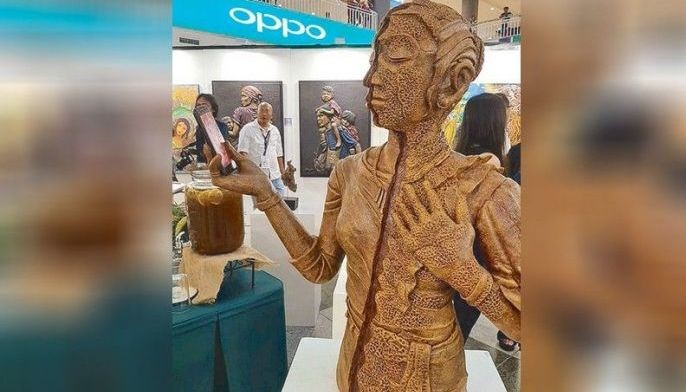“Traversing the river of creativity” was the theme of the first-ever Mindanao Art Fair held recently in Davao. It was met with eager crowds, thirsty for a showcase of the best of Mindanao’s artists. “It’s a good evening to be an artist in Mindanao,” says artist Kublai Millan, the main force behind the art fair, at the exhibit’s opening. “We have taken the first step of gathering Mindanao artists to showcase their talents.”
Kublai, known for his monuments to peace that can be found all over Mindanao, pulled off an equally monumental feat with the Mindanao Art Fair, with the support of his colleagues at Lawig-Diwa and the National Commission for Culture and the Arts.
The inspiration for the Mindanao Art Fair came when Kublai was invited to be a resource speaker at the Visayas Islands Visual Arts exhibit and conference (VIVA Excon), a Visayan answer to the capital-centric Manila Art Fair.
“In VIVA Excon, I saw how art can bring people together to learn and feed from each other,” says Kublai, who saw the need to foster this in Mindanao as well.
“If we are to bring to life an industry that sustains artists, then just setting up exhibits is not the way. More than just helping in putting up shows, artists need to get inspiration on how they can push themselves. Artists need the inspiration to bring their art to the people. Artists need to be in constant touch with their hearts to help define what guides us all together despite our differences,” says Kublai. “We envision Mindanao artists who are grounded and have immersed themselves in their communities and traversed the river to be with the people.”
The Mindanao Art Fair’s main exhibit was held in Gmall, Davao City, bringing works from a wide range of Mindanawon artists to Davao’s mall-going public. Opening night was packed and saw performances by Mindanao’s own Maan Chua, artist Rosalie Zerrudo and Talaandig leader and musician Waway Saway, and even a surprise performance by National Artist for Film Kidlat Tahimik.
Simultaneously, satellite exhibits were held in venues all over Davao, most notable of which was the launch of the Datu Bago Gallery Café of the Davao City National High School. The first of its kind, the gallery-café is run by high school students, who serve as the waitstaff, whose artworks are on exhibit as well.
The works of these high school students are impressive, showing great technique as well as deep concept. The students are also responsible for the mural of indigenous faces on the walls that surround their school.
The real meat of the art fair was the conference held at the Philippine Women’s College. Vim Nadera started off with a thought-provoking keynote speech asking the audience – “Nasaan ang Mindanao sa sining (Where is Mindanao in the arts)?”
Speakers included curator Elba Cruz, who will soon be opening a one-hectare Museum of Art Mindanao together with Kublai; and sculptor Gerry Leonardo, who talked about art education, both on the Building Audience panel.
Leeroy New, Dominic Rubio and Rosalie Zerrudo formed the panel on Artist Curating the Self.
“Mindanao opened my heart, it ripped me open,” says Zerrudo on finding deep connections with the culture and people of Mindanao.
The final panel was on the business of art with Riel Hilario who talked about artist residencies; Pope Dalisay who shared his experiences in joining and winning art competitions; Art Plus magazine’s Jack Teotico on art marketing; and Melissa Yeung-Yap on art as a social enterprise.
“We have to be a self-sustaining industry that is fully immersed in our people and culture… The mission is for Mindanao artists to be active participants of this industry, through bringing out what is unique in our island region,” says Kublai.
On what makes Mindanawon artists special, Kublai says, “The bigger key is in the heart that is embedded in the art. It is all about the heart of the artist that identifies himself in his roots, his people, his land and nurture that desire to give back what his identity has gifted him with within an environment of sustained art and provides for his future and that of the future generations.”
Kublai believes that the future of art – much like indigenous art – is community art, something that the Mindanao Art Fair is hoping to foster.
“Here in Mindanao, art is living, evolving and you can be part of the evolution by setting the right direction.”
A one-day conference was definitely not enough to encompass everything that the speakers wanted to impart to their enthusiastic audience. Throughout the art fair, Kublai and his team were already talking about what they would do for the fair’s next edition.
Fr. Harold Rentoria, OSA, NCCA commissioner for cultural heritage, assured them of NCCA’s support for the coming years of the Mindanao Art Fair. He hoped the second, third and succeeding art fairs would feature even “more activities that will encourage and inspire young artists to continue to hone their craft.”
“The mission is to bring to life a sustainable arts industry in Mindanao. The vision is a thriving community of artists who are grounded in their identity and thus come out to the world offering what is uniquely ours. The vision is to create an environment where young people and old find their identities through creative endeavors that are unique,” says Kublai, as Mindanawon artists, like the river, continuously surge forward.


